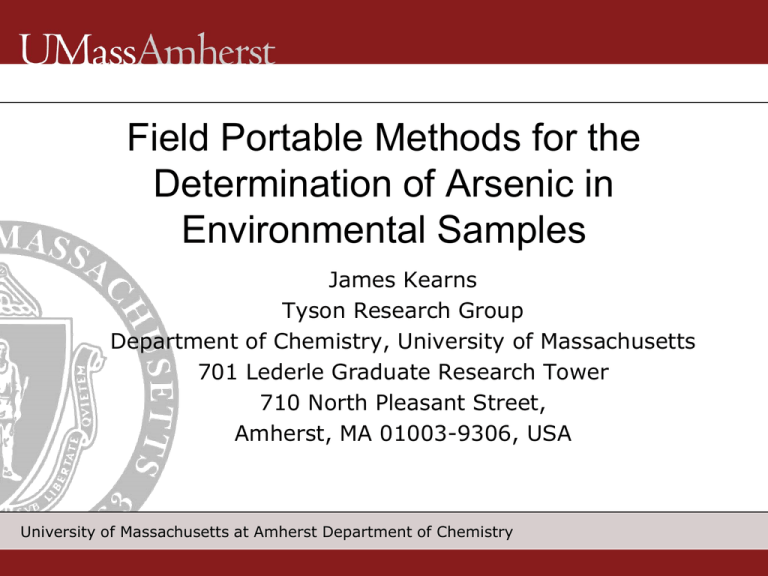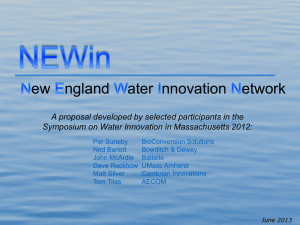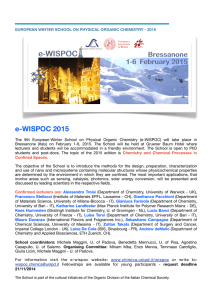
Field Portable Methods for the
Determination of Arsenic in
Environmental Samples
James Kearns
Tyson Research Group
Department of Chemistry, University of Massachusetts
701 Lederle Graduate Research Tower
710 North Pleasant Street,
Amherst, MA 01003-9306, USA
University of Massachusetts at Amherst Department of Chemistry
Presentation Outline
1. Research Goals, the Arsenic Problem, and Field Kits.
2. The Chemical Methods
• The Gutzeit Method: Hydride Generation of Arsenic.
• The Molybdenum Blue Method.
3. Experimental
• Project 1: 24 Hour Field Kit Sensitivity
• Project 2: Measuring Arsenic in Soils with the Gutzeit Method
• Project 3: Silver Nitrate as a Detection Reagent for the Gutzeit Method
• Project 4: Molybdenum Blue and the Detection of Arsenic with
Cameras
• Project 5: Flow Injection and the Determination of Arsenic
• Project 6: The Stoichiometry of Heteropolyacids
4. SNPs Research
5. Future Work
6. Questions
University of Massachusetts at Amherst Department of Chemistry
2
What is the Size of the Arsenic Problem?
Millions of people worldwide are chronically exposed to
arsenic through drinking water, including 35—77 million
people in Bangladesh.
Argos, M. et al. The Lancet, Early Online Publication, 2010
University of Massachusetts at Amherst Department of Chemistry
3
The Goals of this PhD. Research Project
Goal: To develop a more reliable field portable chemical
method to measure arsenic in environmental samples at,
or below, 10 µg L-1 (ppb).
Areas of investigation: (1) Improvement in Gutzeit methodology for
water and soil testing with digital image analysis and use of silver
nitrate as a reagent (2) Optimization of the molybdenum blue
chemistry (3) The single nucleotide polymorphism study to
understand the health consequences of arsenic exposure.
University of Massachusetts at Amherst Department of Chemistry
4
Is There a Need for Field Portable Instruments?
The Challenges of Laboratory Instruments:
(1) High Cost (2) Materials and Maintenance (3) Trained Technician
The Current Reliability of Field Portable Methods:
“Accurate, fast measurement of arsenic in the field remains a
technical challenge. Technological advances in a variety of
instruments have met with varying success. However, the central
goal of developing field assays that reliably and reproducibly
quantify arsenic has not been achieved”
Melamed, D. Anal. Chim. Acta, 2005, 532, 1-13.
The Need for Field Kits:
“The only feasible approach (for the measurement of the tube
wells, which are estimated to be more than 10 million) is through
the use of field kits.”
Kinniburgh, D.G.; Kosmus,W. Talanta, 2002, 58, 165-180.
University of Massachusetts at Amherst Department of Chemistry
5
The Gutzeit Test
Reaction 1 (aq): arsenite + zinc + acid produces AsH3 ,which rises into head space of reaction
container. Reaction 2 (g): AsH3 reacts with mercuric bromide impregnated test strip.
Measurement: Yellow-brown color produced after set time is compared with preprinted chart.
University of Massachusetts at Amherst Department of Chemistry
6
The Gutzeit Method Chemistry
The Formation of Arsine (AsH3)
The reaction of Arsine
Zn(0) Zn2+ + 2e-
AsH3 (g) + 3HgBr2 (aq) As(HgBr)3 (aq) + 3HBr
2H+ + 2e- H2
AsH3 (g) + 3AgNO3 (s) AsAg3 (s) + 3HNO3
As(III) + 3e- As(0)
As(0) + 3e- +3H+ AsH3
Brindle, I. D. “Vapour-generation analytical chemistry: from Marsh to multimode sample-introduction system”
Analytical Bioanalytical Chemistry 388, 2007, 735-741.
University of Massachusetts at Amherst Department of Chemistry
7
Molybdenum Blue Method
Ammonium molybdate, sulfuric acid, a reducing agent and a
catalyst are combined; the molybdate forms an inorganic
polymer, which is then reduced and turns from yellow to blue.
University of Massachusetts at Amherst Department of Chemistry
8
Molybdenum Blue Chemistry
Chemical Reaction: for formation of molybdenum blue
12 MoO42- + AsO43- + 24H+ → AsMo12O403-+ 12H2O
Matsunaga, H.; Kanno, C.; Toshishige, M. Suzuki, T.M. Talanta, 2005, 66, 1287-1293.
Analytes which react with the molybdenum blue chemistry
Molybdate reacts with the +5 species of P, As, Sb, and Bi.
The Stages: of molybdenum blue formation
1. Complex only reacts in a solution containing arsenic (V).
2. After reduction, the complex’s Max is near 850nm.
University of Massachusetts at Amherst Department of Chemistry
9
The “Molybdenum” Blue Complex
Gouzerh, P.; Proust, A. Main-group element, organic, and organometallic derivatives of polyoxometalates. Chem. Rev. 1998, 98, 77.
1. Arsenate + molybdate + acid + reducing agent gives blue color due to formation of
heteropoly species containing both Mo (IV) and Mo (VI).
2. Octahedral subunits form the structure.
3. Arsenic substitutes for a molybdenum or trapped in the interior of the
larger polymer.
University of Massachusetts at Amherst Department of Chemistry
10
Color Measurement and Tristimulus Colorimetry
Photons come in
different wavelengths
According to tristimulus
colorimetry theory, the
human eye interacts
with three regions of the
electromagnetic
spectrum
Detection methods
measure light using
tristimulus theories
Konica Minolta, the essentials of imaging web site
http://www.konicaminolta.com/instruments/knowledge/light/concepts/08.html,
(accessed August, 2010)
University of Massachusetts at Amherst Department of Chemistry
11
Reflectance Spectroscopy
I = I0*e-kx
Reflectance spectroscopy operates according to
Beer’s Law
Where I is observed light
I0 is the original light intensity
The value k is the absorption coefficient specific
for that substance at a specific wavelength.
The value x is the distance the photons travel
through the substance
USGS, about reflectance spectroscopy website, http://speclab.cr.usgs.gov/aboutrefl.html, (accessed August, 2010)
University of Massachusetts at Amherst Department of Chemistry
12
Quantification of Molecules Using Reflectance Spectroscopy
I = I0*e-kx
These methods used a tristimulus scanner
I and Io are known, the precision of the emission of
incident wavelengths and their detection have to be further
established
The value k is the absorption coefficient specific for that
substance at a specific wavelength. The k value is not
known because the reaction products are not
homogeneous or characterized
The value x is the distance the photons travel through the
substance because the thickness of the mercuric bromide
is not known and are not uniform
The USGS reflectance spectroscopy places samples on
glass, this experiment uses white plastic
University of Massachusetts at Amherst Department of Chemistry
13
Project 1: Improving Field Kit Sensitivity using Digital Image Analysis
Time: five replicate measurements at 20, 30, 40 minutes and 24 hours at the
concentrations of 10, 25, 50, 100, 250, 500 µg L-1 (ppb).
Temperature: five replicate measurements at 35° C and the concentrations
of 10, 25, 50, 100, 250, 500 µg L-1 (ppb).
Determinations of (1) s (standard deviation of field kit measurements), (2) S0
(Standard deviation at zero concentration), (3) k (constant relative error) with time
and temperature variations plus scanner use.
The Red, Green and Blue values were measured using computer software.
University of Massachusetts at Amherst Department of Chemistry
14
The Research or Kinniburgh and Kosmus
Thompson, M. Howarth, R.J. Analyst, 1976, 690
Kinniburgh, D.G., Kosmus, W. Talanta, 2002, 58, 165-180
University of Massachusetts at Amherst Department of Chemistry
15
Current Analytical Precision with the Gutzeit Method
Kinniburgh, D.G., Kosmus, W. Talanta, 2002, 58, 165-180
University of Massachusetts at Amherst Department of Chemistry
16
Results: Tables of Standard Deviation Values and Mean Blue Values at Different Times
University of Massachusetts at Amherst Department of Chemistry
17
Blue Pixel Count
The Standard Plot of Color Versus Concentration
Concentration of As(III) g L-1
University of Massachusetts at Amherst Department of Chemistry
18
Blue Pixel Value
The Determination of Standard Deviation in Concentration
Concentration of As (III)
University of Massachusetts at Amherst Department of Chemistry
19
The Values so and k at 24 Hours of Reaction Time
Concentration As (III) g L-1
Standard Deviation in
Concentration
2.3827
25
4.1478
50
6.5894
Standard Deviation of
Concentration
10
As(III) g L-1
University of Massachusetts at Amherst Department of Chemistry
20
Results: Table of So and K Values at Different Times
University of Massachusetts at Amherst Department of Chemistry
21
Blue Pixel Value
Results: Graphs Comparing Time and Temperature
Concentration of As (III) g L-1
University of Massachusetts at Amherst Department of Chemistry
22
Conclusions of DIA Experiment
1. Scanning improves precision compared to naked eye
determination at 20 minutes.
• Naked eye (Kinniburg) k = 0.3 and So = 7.
• This method produced k = 0.2 and So = 2.6.
2. Increasing the reaction time from 20 minutes to 40 minutes
also decreases k (for 20, 30, and 40 minutes) and increases
So(for 20,30, and 40 minutes).
3. Running the reaction at 35°C produces results similar to 40
minutes and 24 Hours.
University of Massachusetts at Amherst Department of Chemistry
23
Conclusions of DIA Experiment Table of s Values at 10 and 50 g L-1
University of Massachusetts at Amherst Department of Chemistry
24








